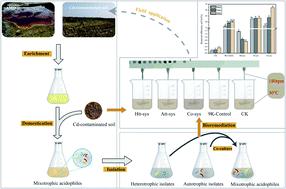Our official English website, www.x-mol.net, welcomes your
feedback! (Note: you will need to create a separate account there.)
Bioremediation of cadmium-contaminated paddy soil using an autotrophic and heterotrophic mixture
RSC Advances ( IF 3.9 ) Pub Date : 2020-7-10 , DOI: 10.1039/d0ra03935g Menglong Xu 1, 2, 3 , Yazi Liu 1, 3 , Yan Deng 1, 2, 3 , Siyuan Zhang 1, 2, 3 , Xiaodong Hao 1, 2, 3 , Ping Zhu 1, 2, 3 , Jieyi Zhou 1, 3 , Huaqun Yin 1, 3 , Yili Liang 1, 3 , Hongwei Liu 1, 3 , Xueduan Liu 1, 3 , Lianyang Bai 2 , Luhua Jiang 1, 3 , Huidan Jiang 2
RSC Advances ( IF 3.9 ) Pub Date : 2020-7-10 , DOI: 10.1039/d0ra03935g Menglong Xu 1, 2, 3 , Yazi Liu 1, 3 , Yan Deng 1, 2, 3 , Siyuan Zhang 1, 2, 3 , Xiaodong Hao 1, 2, 3 , Ping Zhu 1, 2, 3 , Jieyi Zhou 1, 3 , Huaqun Yin 1, 3 , Yili Liang 1, 3 , Hongwei Liu 1, 3 , Xueduan Liu 1, 3 , Lianyang Bai 2 , Luhua Jiang 1, 3 , Huidan Jiang 2
Affiliation

|
Cadmium (Cd) pollution poses a serious risk to human health and ecological security. Bioremediation can be a promising and effective remediation technology for treating Cd contaminated soils. In this study, seven heterotrophic strains were isolated from Cd contaminated soil and 7 autotrophic strains were isolated from acid mine drainage. Cd removal efficiencies were compared after leaching with autotrophic bacteria (Att-sys), heterotrophic isolates (Htt-sys) and cooperative leaching systems (Co-sys) in laboratory agitating reactors. The results indicated that Cd removal efficiency of Co-sys (32.09%) was significantly higher than that of Att-sys (23.24%) and Htt-sys (0.74%). By analyzing the soil microbial community in different bioleaching systems, we found that the addition of heterotrophic isolates significantly promoted the growth of some heavy metal resistant inhabitants (Massilia, Alicyclobacillus, Micromonospora, etc.), and Co-sys had a minor effect on the growth of soil indigenous microbes. In Co-sys, the content of the four Cd fractions all decreased compared with other leaching systems. The analysis of soil physicochemical parameters during the leaching process showed that pH and ORP (oxidation reduction potential) were not the only determinants for Cd removal efficiency in Co-sys, synergistic metabolic activities of autotrophic and heterotrophic strains may be other determinants. This study demonstrated that cooperative bioremediation may prove to be a safe and efficient technique for field application in heavy metal soil pollution.
中文翻译:

自养和异养混合物对镉污染稻田土壤的生物修复
镉(Cd)污染对人类健康和生态安全构成严重威胁。生物修复是一种很有前景的有效修复技术,可用于处理 Cd 污染的土壤。本研究从镉污染土壤中分离出7株异养菌株,从酸性矿山排水中分离出7株自养菌株。在实验室搅拌反应器中用自养细菌 (Att-sys)、异养分离物 (Htt-sys) 和协同浸出系统 (Co-sys) 浸出后,比较了 Cd 去除效率。结果表明,Co-sys(32.09%)的Cd去除效率显着高于Att-sys(23.24%)和Htt-sys(0.74%)。通过分析不同生物浸出系统中的土壤微生物群落,Massilia、Alicyclobacillus、Micromonospora等) 和 Co-sys 对土壤原生微生物的生长影响较小。在 Co-sys 中,四种 Cd 组分的含量均低于其他浸出系统。浸出过程中土壤理化参数的分析表明,pH和ORP(氧化还原电位)不是Co-sys中Cd去除效率的唯一决定因素,自养和异养菌株的协同代谢活性可能是其他决定因素。该研究表明,协同生物修复可能被证明是一种安全有效的重金属土壤污染现场应用技术。
更新日期:2020-07-10
中文翻译:

自养和异养混合物对镉污染稻田土壤的生物修复
镉(Cd)污染对人类健康和生态安全构成严重威胁。生物修复是一种很有前景的有效修复技术,可用于处理 Cd 污染的土壤。本研究从镉污染土壤中分离出7株异养菌株,从酸性矿山排水中分离出7株自养菌株。在实验室搅拌反应器中用自养细菌 (Att-sys)、异养分离物 (Htt-sys) 和协同浸出系统 (Co-sys) 浸出后,比较了 Cd 去除效率。结果表明,Co-sys(32.09%)的Cd去除效率显着高于Att-sys(23.24%)和Htt-sys(0.74%)。通过分析不同生物浸出系统中的土壤微生物群落,Massilia、Alicyclobacillus、Micromonospora等) 和 Co-sys 对土壤原生微生物的生长影响较小。在 Co-sys 中,四种 Cd 组分的含量均低于其他浸出系统。浸出过程中土壤理化参数的分析表明,pH和ORP(氧化还原电位)不是Co-sys中Cd去除效率的唯一决定因素,自养和异养菌株的协同代谢活性可能是其他决定因素。该研究表明,协同生物修复可能被证明是一种安全有效的重金属土壤污染现场应用技术。











































 京公网安备 11010802027423号
京公网安备 11010802027423号